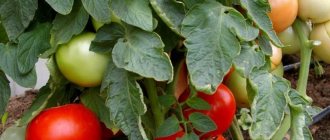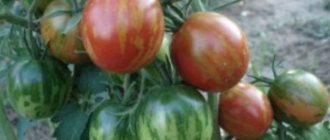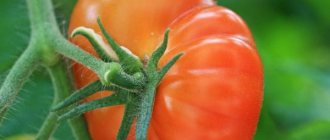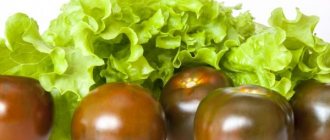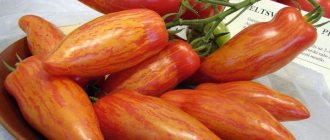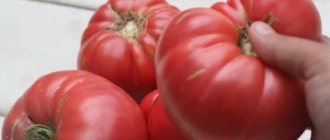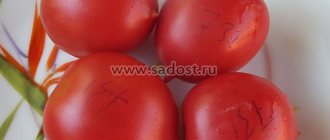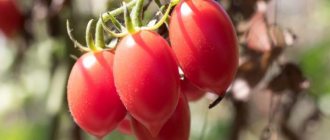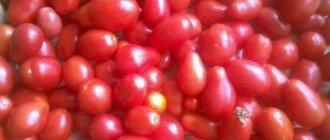Especially for farmers, breeders have prepared a fruitful new product - Handbag. The fruits have a neat cuboid shape, slightly flattened on the sides. They contain all the beneficial elements of tomatoes, many antioxidants and vitamins.
| Height | Landing location | Ripening time | Fruit color | Fruit size | Origin | Fruit shape |
| Tall | Greenhouse, Open ground | Mid-season | Reds | Average | Variety | Plum-shaped or oval |
Features of the variety
The characteristics of the plant will give the beginning summer resident the opportunity to properly grow tomatoes on the plot and get the best possible result.
Plant:
- Bush: indeterminate.
- Height: 1.6–1.8 m.
- Inflorescence: simple.
- Number of tomatoes in a brush: 3–5 pcs.
- Ripening time: 110–120 days.
Fruit:
- Shape: cuboid.
- Color: red-pink.
- Weight: 200–250 g.
- Density: high.
- Number of cameras: 4–6 pcs.
- Transportability: high.
- Shelf life: 1–1.5 months.
I. Hybrids
Hybrid tomatoes are virtually guaranteed to be resistant to diseases and bad weather conditions, which is something that non-hybrid varieties suffer from. Greenhouses and greenhouses are valued for storing heat, but in them tomatoes can suffer from too high temperatures and sudden temperature changes. In recent years, world selection has been aimed at producing “heat-resistant” hybrids with a reliable guarantee of ovary production.
Hybrids are especially helpful in a greenhouse or a small garden plot where there are no real opportunities for crop rotation and diseases are prevalent. Selection successes demonstrate confident resistance to various types of infections - viral (especially the most dangerous tobacco mosaic virus), fungal, bacterial. In addition, the hybrids have uniform fruits and consistently high yields.
Tomato Incas F1
One of the best hybrids for canning whole fruits without skin. Popular early high-yielding bush hybrid. The plant is medium-sized, compact.
Tomato from the Dutch company Numens, zoned in Russia; entered into the state register in 2000. Mid-early hybrid (105 days) of meter-high vegetables, determinate. Very high resistance to fungal diseases has been recorded. The fruits are 80-100 g, dense, bright red, pepper-shaped, fleshy, uniform, tolerate sunburn well, are very easy to ripen, transported over long distances without loss of quality.
Tomato Torquay F1
Dutch hybrid from Bejo Zaden; in the Russian register since 2007. Mid-season tomato (119-123 days from germination to ripening), bush type - determinate, maximum height 100 cm. Forms abundant multiple clusters with fruits weighing 60-140 g. Dense tomatoes withstand long-term transportation, excellent in pickling and pickling matters.
Tomato Mariana F1
The tomato was created in the French branch of the Japanese company Sakata (the image of the woman Mariana is a symbol of the French Republic). The breeders of this agricultural company are often suspected of producing GMOs, but so far without real evidence. Mariana is a mid-early determinate hybrid. The fruits are similar in shape to Incas - also elongated-oval, perfectly smooth, super dense.
Tomato Bagheera F1
Hybrid from the leading French seed company Cloz. Included in the Russian seed register in 2007.
Early high-yielding hybrids are a real boon for the garden. They are cold-resistant, do not need pinching or tying up, and practically do not get sick. The ripening period is marked as medium-early; determinate bush. The fruit is round, flattened on top, ribbed, weight ranges from 80-220 g. The hybrid is resistant to soil drought and nematode, more suitable for regions located in the south. Does not suffer from fusarium and verticillium wilt.
Tomato F1 Semko 2005
The tomato is suitable for open ground and under film shelters (greenhouses). Determinate, medium-sized, compact. Resistant to soil salinity, drought, high temperatures, grows well in open ground in both southern and northern regions. Vegetables practically do not suffer from viral and fungal diseases, even late blight.
Tomato F1 Semko 2010
Included in the state register in 2010. Ultra-early ripening determinate hybrid - 85-88 days pass from the sprouting of green vegetables to the coloring of fruits. The first brush is formed immediately after the sixth leaf grows. The fruits are incredibly dense for such an early tomato, and are by no means small - 130 g. The shape is round hearts with a beautiful pointed tip.
In open ground, we usually plant thickly - 5-6 bushes per square. The best harvest from such an area is at least a bucket. The hybrid is highly resistant to bacteria, fungi and viruses. Does not crack and does not suffer from blossom end rot. Successfully withstands high temperatures and dry soil.
The newest indeterminate hybrid (on the register since 2015) - tested by us, everything is fine - created taking into account all possible greenhouse disasters. Firstly, it sets well even in the heat, as well as during temperature changes. Secondly, it is tolerant of problematic soil substrates. Thirdly, it shows high resistance to viral, fungal and bacterial infections.
The yield of vegetables varies between 20-30 kg/1 square meter. Mid-early hybrid (100 days from green shoots). The clusters begin to form after 7-9 leaves, each bears 5-6 tomatoes in the shape of rounded hearts, smooth, beautiful, attractive orange color. The weight of the “heart” is 160-190 g. The pulp contains a high percentage of dry matter, sugars, and carotenoids.
READ MORE: Ultra early ripening tomato characteristics and description of varieties for open ground
Bushes of unlimited growth, with dense foliage. Mandatory shaping is required, including a garter. Hybrid of medium early or medium ripening period (112-118 days). Clusters of 6-8 tomatoes weighing 130-150 g. The fruits are plum-shaped, slightly tapering downwards. They are deep red in color, thick-skinned, with a high percentage of dry matter.
Tomato Empire F1
Indeterminate hybrid of a new generation, in the state register since 2011. Medium-early (100 days - 2 days - from germination). The plant is tall, much taller than other types of tomatoes. Therefore, the tomato requires gartering and pinching. Tomatoes are oval-shaped with a spout, weight ranges from 80 to 140 g. On average, 9 kg are obtained per bush. The color of the fruit is red-orange. The skin and pulp are dense. Can be stored for 6-7 weeks. In greenhouses people do not suffer from viral and fungal infections.
On the register since 2015. The bushes are semi-determinate, beautiful, a meter and a half high. Suitable for any soil - open or closed. Plants require pinching. Multiple clusters bear up to 30 fruits with a sweet taste and a perfect “strawberry” shape. The weight is typical for classic cherry tomatoes - 25 g. Thanks to the strong skin, the fruits can be stored for a long time. Early hybrid: ripe fruits appear 91-93 days after the sprouts emerge. The plant is resistant to Fusarium wilt.
Tomato F1 Kaspar
The bush is short, usually up to the first cluster, 60 cm. The fruits of the plants are cylindrical with a spout, the length varies around 11 cm, and the weight is 95-115 g. They are very dense, without juice. It is convenient to pickle them assorted with cucumbers of a similar size.
The average ripening period is 115 days. The hybrid is intended for open ground, or is planted under low shelters; We plant three to four vegetable bushes per square.
Tomato Aunt Valya F1
Valya f1 tomatoes are early-ripening, tall hybrids with average yield. The bushes easily and quickly reach a height of 200 cm. In the register since 2015. Productivity is within 20 kg per square meter. On average, one bush produces 7 kg of tasty and beautiful tomatoes. Tomatoes ripen simultaneously, reaching 200-250 g in weight.
The fruits have a regular round, slightly oblong shape. The scope of use of tomatoes is very wide. Salads are prepared from the first fruits. As the volume of the harvest increases, the fruits are used for winter harvesting, as well as juices, ketchups, pastes, sauces and lecho. Tomatoes retain commercial quality for a long time and tolerate transportation and long-term storage well.
Planting and care
The seedling growing method is used. Seeds are sown 60 days before planting in the ground. The timing is calculated individually, taking into account the climate of the region of residence. At phase 2 of the true leaf, tomato seedlings are plucked. Hardening of the plants is required, usually this is done 10 days before transplanting into the ground. She is taken outside, left for 20 minutes every day, this time increases. On the 10th day it should be approximately 8 hours.
It is best to form 2 stems.
2–3 plants are placed per 1 m2. It is recommended to fertilize. At least 2 times, during the period of flowering and active ripening. Weeding, loosening, and weed removal are mandatory in order to reduce the risk of exposure to the main diseases of the species. Watering in the evening with warm water.
Description of the early ripening tomato Spring of the North F1 and rules for growing by seedling method
The early-ripening hybrid tomato Spring of the North was included in the State Register of Breeding Achievements back in 2011. Bred specifically for the industrial production of early vegetables, the variety has several advantages: uniform yield, calibrated fruits and compactness of the bush. Currently, hybrid seeds can also be purchased for planting in a summer cottage.
General characteristics of the plant
The description of the variety Spring of the North F1 in the State Register catalog indicates that this is a determinate plant. The growth of the main stem stops after the formation of 5-6 fruit clusters, after which the filling of the ovaries and the rapid ripening of the fruits begin. Mass harvesting takes place in July, but the first fruits begin to ripen at the end of June.
To obtain early production, it is recommended to grow tomatoes in greenhouses. But in summer cottages in central Russia and Siberia, it is possible to obtain a tomato harvest in open ground. The plant is very resistant to temporary drops in temperature, tolerates prolonged rainfall well and is practically not affected by macrosporiosis in hot and humid seasons.
Reviews from domestic gardeners indicate that the variety’s yield remains consistently high in any summer.
To improve the yield of the crop, it is recommended that after the first cluster blooms, remove side shoots that do not produce additional fruits.
At the same time, the plant directs all the nutrients to the filling and ripening of tomatoes on the main stem.
Description of the fruits of the hybrid Spring of the North
5-6 fruit clusters of complex shape are formed on the plant. Each of them bears an average of 4-5 fruits with approximately the same weight (no more than 200 g). The shape of the berries is round, the stalk is slightly ribbed.
The skin is dense and durable. Vesna Severa tomatoes are not subject to cracking, are well transported and last a long time without losing their appearance or taste.
When harvesting fruits at milky ripeness, tomatoes ripen easily in room conditions. The color of a ripe tomato is a rich pink hue, with a pearlescent tint.
Tomatoes at technical ripeness have a pale green color with a dark spot at the base.
The Spring of the North hybrid has a salad purpose. The first harvest of vegetables is harvested in early summer, when there is a shortage of them, so tomatoes are mainly consumed in the form of summer snacks and salads. The slices are suitable for sandwiches; pink slices also look elegant when sliced.
Small calibrated tomatoes are convenient for whole-fruit canning. Thanks to the elasticity of the skin and pulp, canned tomatoes hold their shape well and remain intact during heat treatment.
If desired, you can get thick tomato juice and light-colored puree from fleshy tomatoes.
These products contain little acid and are suitable for dietary purposes, are hypoallergenic, and are recommended for baby food as a source of many vitamins.
How to grow early tomatoes
Early varieties of tomatoes need to be sown as seedlings 2 months before the intended planting. To obtain a harvest at the beginning of summer, the plants need to be planted in a greenhouse. In the conditions of central Russia, this can be done in mid-May.
Tomatoes are planted in the ground when the spring wave of return frosts has passed, that is, around the beginning of June. By combining both technologies, you can have fresh vegetables on the table from mid-June to the end of July. After this, medium-ripening tomatoes begin to be harvested from the garden.
You can sow seeds in boxes 2/3 filled with soil made from equal parts of garden soil, humus and fine sand. For 5 kg of such a mixture, it is advisable to add 1 tbsp. ground chalk or eggshells. Before sowing, calcine the soil in the oven or soak it in a hot dark pink solution of potassium permanganate.
Seedlings dive in the phase of 2-3 true leaves according to a 10x10 cm pattern. Caring for seedlings consists of timely watering and additional lighting, if necessary. When the time for planting approaches, the plants are placed in 5-6 bushes per 1 m².
Disease susceptibility
Tomatoes of the “Sumochka” variety are not immune to diseases, so timely treatment with drugs against the development of viruses and fungi is required. Prevention can begin from the moment of sowing by treating the seeds used for planting.
If the disease has affected an adult plant with fruits, it is better not to use chemicals. Folk remedies will help.
Dosed watering, timely weeding and other agricultural practices are preventive measures.
Tomato Northern Beauty - description and characteristics of the variety
The Northern Venus tomato is the leader among tomatoes used for preservation. Their excellent feel and high level of productivity distinguishes the variety from many others and always brings it more popularity.
Northern Belladonna tomatoes are indeterminate, mid-season varieties. Bushes of an adult plant reach 1.5 m in height and have bright green foliage of medium size.
Agronomists note Gulliver's immunity of the plant. The Northern Beauty variety is resistant to pathogens of such diseases no worse than fusarium and TMV. In addition, this tomato variety tolerates dry periods and temperature changes well.
Breeders guarantee that this variety is capable of growing well and bearing fruit in any climatic region. The seedlings successfully grow and bear fruit both in greenhouse conditions and in open summer cottages.
The variety has a high yield. From 1 square meter (God) ordered to collect up to 4.1 kg of ripened fruits, each weighing 60-120 g.
Fruit characteristics
The berries of the Northern Beauty are elongated, with a characteristic pointed tip. Ripe tomatoes have a rich, pink color, while unripe ones have a light shade of green with darkening at the base.
From one inflorescence, 6 pieces of fruits are formed, which have 6 chambers with seeds. Their pulp has a dense structure.
Housewives use Northern Beauty buttocks for canning whole fruits, preparing juices, salads, first and second courses.
Plant etiolation
To achieve a high level of fruiting, it is necessary to observe the nuances during germination, transplantation and further care.
Growing the Northern Madonna Raphael variety begins with the germination of seed material. Agronomists recommend starting this process 55 days before the planned transplanting of young plants into the garden. Germinating Northern Beauty seeds has its own characteristics:
- Fumigation of seeds.
Before planting seed material in containers with soil, it is necessary to disinfect them. To do this, use a weak solution of manganese. - Preparing the container and soil.
Experienced summer residents advise choosing separate, small containers. This will facilitate the subsequent process of transplanting seedlings to the garden bed. It is recommended to choose (make nutritious, loose soil. - Sowing.
The seeds are placed in containers filled with soil, deepening them no more than 1 cm. - Greenhouse conditions.
Experienced gardeners recommend lining the container with film to achieve a greenhouse effect. To prevent soil mold, it is inevitable to remove the film periodically. - Picking.
After the appearance of 2-3 true leaves, the seedlings should dive.
The readiness of seedlings for transplantation to a permanent place of growth is indicated by the appearance of 5-6 true leaves. Experienced vegetable growers advise replanting in the evening or on cloudy days to prevent severe sunburn on the top of the leaves, which can lead to the death of the plant.
Features of care
The Northern Red tomato requires special attention to its care and compliance with certain rules:
- Linear, moderate watering.
It is necessary to irrigate the soil as its top layer dries. - Timely removal of weeds.
Weeds can acidify the soil. In addition, they can become a source of spread of parasites. - Loosening the soil.
Loose soil provides Novgorod freemen with access to air and moisture. - Introduction of fertilizers.
To feed tomatoes, use mineral or organic fertilizers, which are introduced according to the instructions. - Treatment with biostimulants.
To improve plant growth, it is permissible to use biogrowth stimulants. - Garter to support.
Bushes of this variety reach 1.5 m in height and need to be tied to a support. The vertical location of the plant ensures its health and proper distribution of nutrients. - Acute harvest.
Ripe tomatoes take a lot of energy from the plant, what's the matter? negatively affects its general condition and ability to nourish unripe pomona gifts.
Compliance with the rules of care guarantees not only good fruiting, but also high taste characteristics of the fruit.
The Northern Beauty variety is distributed throughout Russia and beyond. Its features ensured fame among experienced summer residents, and its taste characteristics conquered many people.
Harvest volume and application
If you follow all the rules and requirements when planting and caring, then from 1 bush you can get about 8 kg of tomatoes. Thus, the yield of 1 m2 will be 15–20 kg.
See also
Characteristics and description of the tomato variety King of the Market, its yieldRead
Tomatoes are used for fresh vegetable salads and festive table decorations. They are also used for processing into tomato paste, sauces, ketchups and juices.
II. Indeterminate varieties (unlimited growth)
These are tomatoes that will grow until they turn blue until the owner or the onset of the cold season stops them. They have great yield potential, which is more successfully realized in high greenhouses. We place approximately three bushes on 1 square. With supports such as strong trellises, open ground is not prohibited, which will be especially welcome in the southern regions.
Tomato Scarlet candles
Good for pickling, sweet. This is a patented mid-early variety (Siberian breeders distinguished themselves!). In the state register since 2007. They are characterized by a high ability to form ovaries in any conditions. From 1 sq.m you can actually get a bucket and a half. The clusters are arranged in tiers, the weight of the fruit on the lower branches reaches 120 g, on the top ones - half as much.
Very lightweight. A mid-early Siberian variety for canning whole vegetables. The fruits are elongated, reaching (maximum in our conditions) 13-14 cm in length, weighing about 120 g, and have a beautiful crimson hue. They have few seeds, are very fleshy, strong, and easy to keep. If they are picked green, they do not spoil and ripen perfectly. The variety is very responsive to high-quality fertilizing.
The longest
A new product of Siberian selection. It begins to ripen already on the 110th (you can add a couple more) days from the sprouts appearing on the surface of the soil. Fruits have a unique length - 20 cm (specific size)! They are very elongated, with a small pear-shaped constriction in the upper part, uniformly slightly expanding downwards, with a spout.
High yield
The variety is productive and unpretentious. Tolerates slight shading. It ties well. Neither high nor low temperatures are scary. It succeeds in protected soil, but outdoor cultivation is not prohibited. Tomatoes begin to ripen in 106-113 days; at the same time, the plant successfully continues to grow and form clusters - up to 10 pieces per bush.
Each bears up to eight graceful fruits - cylindrical and pointed, in full ripeness - iridescent pink in color. The weight of each vegetable is 100-120 g. They contain a high percentage of sugars and dry matter. They do not burst when pickled, are good for drying, obtaining thick juice and, oddly enough in your opinion, for making tomato jam. With diligent care, the bush can bear up to a bucket of quality fruit.
Tomato Niagara
Weighty brushes
This mid-early vegetable variety has been on the state register since 2010. The bush is tall, but compact in width. It has a highly branched root system, responsive to increased nutrition and good water supply. A valuable feature of this Siberian variety is its multiple clusters, each of which bears up to 14 fruits weighing 85-115 g.
Meaty and sweet
This is one of the sweetest and meatiest products of Siberian breeders. It has been registered in the state register since 2007. The tomato is mid-season (116-118 days from the appearance of sprouts), with large foliage. The fruits resemble long, sharp peppers - they grow up to 15 cm. They are an elegant red color, the weight ranges from 120-185 g. The pulp of vegetables contains very little water and seeds. In the best case, there are up to a dozen fruits in one cluster. One bush gives 2-3 kg.
Tomato Koenigsberg
Excellent ovary
Included in the state register in 2005. The variety rightfully takes its place among the most productive Siberian varieties (up to 20 kg per square meter of land in a greenhouse). It sets perfectly even in the hot atmosphere of closed ground. Plants with a powerful bush with large leaves require increased nutrition and careful pinching.
The first ovary is formed after the growth of the 12th leaf, then inflorescences are formed every 3 leaves. Refers to varieties of medium ripening; in Siberian conditions, approximately half of the crop ripens; the rest of the fruits turn red quite well when ripened. Tomatoes in the lower clusters of vegetables weigh 300 g, and in those above - no less than 150 g. The shape is elongated, heart-shaped, smooth, and beautiful.
Vitamin and sweet
Ripe tomatoes have a golden-orange color and contain a record amount of carotene vitamins. The pulp is sweet and aromatic, like berries and fruits. The ripening period is average. The lower fruits are capable of filling up to a mass of 400-450 g, higher up the bush - 200-300 g. They are oval, often with a spout. The plants grow clusters through the leaves, each containing on average, as stated, up to 5 fruits. Productivity is high. The keeping quality is excellent. It is especially tasty when salted with gelatin.
Harvest hearts
Close internodes and a powerful trunk with dense foliage are like standard varieties, only the height is two meters. The Siberian breeding novelty produces half a bucket of fruit from one such “tree”. Ripening begins on the 115th day. Forms up to 6 beautiful clusters with 5-7 red tomatoes weighing 200-250 grams, shaped like strawberries.
Tomato Budenovka
Resistant to cracking
The variety is an improved version of Ox Heart, with a higher yield (about 9.4 kg per square), early ripening, good resistance to diseases (even to late blight) and cracking of the apical tissue of the fruit for a fleshy variety. Heart-shaped, ribbed tomatoes with excellent taste.
Record weight
The variety is a new product from a team of breeding scientists under the leadership of V.F. Gavrisha. Registered in the state register in 2015. Due to the unrealistically large fruits of vegetables, it is included in the “Russian Hero” series. The variety is not very fast in terms of ripening time (from 120 days), therefore it requires early planting of seedlings, especially careful pinching and decent feeding.
In Siberia and Central Russia it works well only in closed ground conditions, including a greenhouse. The average return from a bush is 3.6 (plus or minus) kg, the record is 7 kg. The tomatoes are flat-round, slightly ribbed, have an excellent smell and are very juicy, each weighing 400-600 g, not uncommon - 800 g. There are 2-3 tomatoes in one cluster of plants; if you leave only one tomato in it, it can pull more than 1 kg. Such “bogatyrs” are better suited for salads and distillation for juice.
Bowl of salad from one fruit
READ MORE: Tomato female share f1 characteristics and description of the variety with photos
One of the best salad novelties, the yield is high. The plant bears 5-6 racemes. The fruits look very attractive due to their raspberry-pink color, large up to 500-800 g. The tomatoes are flat-round, ribbed, sweet. There is high resistance to cracking; The pulp density is average. A rare quality for large-fruited varieties: the fruits do not tend to quickly soften and spoil during storage.
According to the ripening period, the variety is classified as mid-early and mid-ripe. Perfect for preparing preparations: tomato paste, juice. This tomato variety is characterized by high yield. You can remove up to 5-6 kilograms of tomatoes from one bush.
Giant orange sweet
It has plasticity, rare for a large-fruited variety, and relative unpretentiousness. Delicate sweet pulp combines with excellent keeping quality. The tomatoes are round-flat (their “ribs” stand out a little), sunny orange in color. The average weight of a tomato is 0.5 kg, but in reality there are 1 kg of fruit on the bush.
Tomato Honey Drop
Sweet babes
Tomatoes from the “cherry” group, original in shape and color. Golden-yellow “pears” weight 30 g. Potato-type foliage, the bush of the plant is incredibly branched: stepsons strive to grow even at the ends of the flower racemes. But in the greenhouse you still need to remove the branches (at least partially), otherwise you will end up with a jungle.
Plum sweets
A modern variety of breeders under the leadership of V.F. Gavrisha, a new product in the group of cherry tomatoes - the Monisto series. The year of entry into the state register is 2015. First harvest on the 115th day. The tomatoes are oval, weighing 25-40 g, collected in clusters of 30 pieces. The variety is the most unusual in color among tomatoes. It has fruits of a brown-burgundy hue, with a specific set of vitamins and an original taste.
Positive and negative properties of the variety
A description of tomatoes and dividing them into pros and cons helps the summer resident decide on the choice of one type or another.
Pros:
- Productivity.
- High transportability and long shelf life.
- Preservation of presentation.
- The fruits do not crack.
Minuses:
- Susceptible to diseases.
- Requires bush formation.
Tomato variety Babushkino: description, characteristics
The Babushkino tomato variety is considered by many to be a masterpiece of domestic selection. It is distinguished by those gardeners who annually plant up to several dozen varieties to compare characteristics. The variety was developed by Russian amateurs, and this happened less than 20 years ago, so it can rightfully be called an achievement of the 21st century.
Tomatoes are not yet included in the State Register, and the sale of seeds is carried out not by large agricultural firms, but by collectors. Despite the unassuming name, the variety is considered elite due to its exceptional large fruit, dense pulp and impressive yield.
Gardeners in the Leningrad, Voronezh, Krasnoyarsk regions, and many other regions are satisfied with growing Babushkino tomatoes. The difference is that in the south it grows outdoors, while in the north it is grown in greenhouses.
Description
The fruits weigh 300-400 grams, and this is not the limit: specimens weighing 700 and even 800 grams are often found. From the lower brushes to the upper ones, the decrease in size occurs smoothly and less pronounced than in similar varieties.
The shape is round, slightly flattened, with ribs near the stalk. The skin is red, sometimes with a pink tint, glossy, the flesh is dense. The taste is rich, sweet with pleasant sourness and a real tomato aroma. According to reviews, the surface sometimes cracks, so during ripening you should carefully monitor the soil moisture, avoiding sudden changes.
Juices, sauces and purees from tomatoes are simply wonderful, and, of course, from July until autumn, fresh salads are prepared from them. The variety is mid-season, begins to bear fruit 110-120 days after germination. You can ripen the fruits in storage.
| Color | red |
| Weight | 300-400 g |
| 4,7 / 5 | |
| 3.5-4.5 kg |
| type | indeterm. |
| 1.5-1.8 m | |
| Term | 100-120 days |
| strong |
Productivity and cultivation
The yield is about 4 kilograms per plant. The plants are indeterminate, with bright green leaves of the usual type. The bushes are not standard and can reach 2 meters or more. Unpretentious, rarely damaged by pests and diseases at a high level of agricultural background.
For growing in greenhouses, seeds for seedlings are sown at the end of February, and for open ground - a little later, in March. Conveniently, this miracle variety is not a hybrid, so gardeners can harvest the seed material themselves and share it with others.
The resulting seed material is treated with a growth stimulant before planting. You can use synthetic drugs sold in stores for this, or you can take honey or aloe juice. Then the seeds are laid out in furrows in prepared, moist soil, placed in a warm place and wait for seedlings to emerge.
After this, expose the plants to light and, if necessary, add additional light so that they do not stretch. In the phase of two leaves they are picked. They are planted on the beds at about two months of age.
Seedling care
Care is standard for this type of tomato. They are planted at sufficient intervals, always near strong trellises. They are formed into several stems, from 2 to 4. During the entire growth period, the stems are tied to the supports, and when the crop is filled, each brush is strengthened. They shoot constantly, without waiting for more than five leaves to appear on the axillary shoots.
It is necessary to fertilize the plants: this hardworking variety requires a large amount of nutrients.
Babushkino is very sensitive to potassium and magnesium; it is with their deficiency that unripe yellow “hangers” appear on the fruits.
This usually happens during the hottest months of summer, so some people mistakenly associate spots with excessive exposure to the sun. The remaining manipulations, weeding, watering, preventive treatments, are known to all gardeners.
Tomato Grandma's Basket
There are several other varieties with similar names. For example, the indeterminate tomato Babushkino Lukoshko is even newer; it was bred by specialists from the Gavrish agricultural company and passed state registration in 2015. Also declared as tall and large-fruited, medium-early ripening and long-term fruiting.
Among the distinctive features, the originators promise good resistance of the variety to a lack of light and space. This expands the geography of its cultivation even further north and increases its economic value.
Tomato Grandma's gift
But the Grandma’s Gift tomato is a hybrid registered in 2010. It is also red-fruited, with tasty, large, juicy tomatoes. It ripens over a fairly long period of 115-125 days. When cultivating, it is taken into one stem and the growing point is pinched. It is drought-resistant and heat-tolerant, which is especially valuable in the southern regions.
The opinion of summer residents regarding the “Sumochka” tomatoes
Often, reading reviews from gardeners about tomatoes can provide more valuable information. Because this is where gardeners share their emotions and specific tips on growing.
- Faith. He has been growing tomatoes for 3 years in a row. I am satisfied with everything, the taste, yield and aroma of tomatoes. I especially like it fresh. Will continue to plant.
- Natalia. I formed the plant into two stems and removed the growing point. The harvest volume is excellent, the fruits are large and tasty. Will grow more.
“Handbag” tomatoes, which many summer residents plant solely because of their high yield. But, besides this, they are able to decorate any area.
Tomato Hospitable
Mid-season, super-yielding, medium-growing, determinate variety of tomatoes of Siberian selection. Recommended for growing in greenhouses and open ground. The period from germination to the beginning of ripening is 115-120 days.
The bush is spreading, its height under normal conditions is 0.8-1 meter, it does not need to be pinched, but it is advisable to tie it to a support. We got the best results when forming plants with 2 and 3 stems. That is, we left 2 stepsons - under and above the first flower brush, and broke out the rest.
formation of determinate tomatoes
Basic qualities of fruits
The fruits are flat-round, slightly ribbed towards the stalk, smooth, bright red in color at maturity, weighing 350-600 grams, fleshy, with tender, sugary pulp. These tomatoes have excellent flavor, making them ideal for fresh consumption. They are also suitable for making juices and sauces.
If you normalize the number of ovaries on a plant, you can easily grow fruits weighing up to 1 kg.
Advantages of the variety: good and stable yield, resistance to temperature changes and insufficient lighting, high taste and marketable quality of the fruit.
The variety is not susceptible to fusarium, cladosporiosis and tobacco mosaic virus.
In 2006, the Khlebosolny tomato variety was included in the State Register of Breeding Achievements in the Russian Federation for cultivation in open ground on private farms.
Features of cultivation, planting and care
Sowing the seeds of this variety of tomatoes for seedlings is carried out 60-65 days before the intended planting in the ground. Picking - at the stage of 2 true leaves. When transplanting seedlings to a permanent place, 1 sq. m it is recommended to place up to 6 plants. Planting pattern: 30 x 50 cm.
Further care for tomatoes consists of timely watering, weed removal, fertilizing, pinching and preventive measures to protect the crop from diseases and pests.
Tomatoes Salted, video
The producer of seeds of this variety is the agricultural company Siberian Garden.
If you grew Khlebosolnye tomatoes, please write whether you liked them or not. What was the yield and taste of the fruits like under your climatic conditions? How do you assess the resistance of this variety to pest diseases? Write briefly the advantages and disadvantages of this tomato in your opinion. If possible, attach a photo of the entire bush or individual fruits you grew to your comment. Thank you!
Your reviews of the Hospitable tomato and additions to the description will help many gardeners evaluate this variety more objectively and decide whether it is worth planting or not.
Tomatoes, cucumbers, basil from the House of Seeds
The company was founded in 1934 to provide high-quality seed material to the North-West region. The work of the breeding department is aimed at amateur gardeners. The assortment includes varieties and hybrids of early-ripening tomatoes and cucumbers that have a short growing season, are resistant to temperature changes and diseases, and are unpretentious in agricultural technology. Many varieties ripen and bear fruit in open ground.
Cucumber F1 Tarapunka
Parthenocarpic hybrid for greenhouses and open ground with very tasty, absolutely no bitterness fruits (3-5 pieces per node). Lateral branching of the vines is limited.
Hybrid of gherkin type, female type of flowering, 3-5 ovaries per node. Early ripening, productive. Can be grown in film greenhouses and open ground. The fruits are smooth, medium-tubercular, 8-11 cm long, genetically without bitterness. Resistant to a range of diseases. Excellent taste.
Tomato Irish liqueur
This is a green-fruited variety with tasty, sugary fruits. Recommended for people prone to allergies.
Mid-early variety (115-120 days from germination) for growing in greenhouses. The plant is indeterminate and powerful. There are up to 5 fruits in a brush.
Tomato Pink Whale
It is resistant to bad weather, so it produces high yields even in unfavorable years.
Early ripening (115 days from germination), indeterminate variety for greenhouses and open ground in the southern regions. The first inflorescence is above the 7-8th leaf. There are 4-9 fruits in a cluster. Each subsequent brush is laid through 2 sheets. The fruits are pink, large, heart-shaped, weighing 200-350 g. The pulp is pink, fleshy, sweet, low in seeds. Productive, tasty, resistant to unfavorable growing conditions.
Tomato Pepper
A very productive variety, one of the best in the group of short tomatoes with elongated fruits. It is characterized by high yield even in cold and damp summers.
Pros and cons of the method
The method in question has the following advantages:
- bags can be placed in a convenient place and moved if necessary;
- when it gets colder, the “vegetable beds” can be moved to a warm room;
- due to the rapid heating of the soil, the crop ripens one to two weeks earlier;
- easy to maintain (no need to dig or weed);
- nutrients and water go directly to the roots, so the yield is pleasing;
- the risks of fungal diseases are minimal (the tomatoes are located high off the ground and well ventilated).
Gardeners note the following disadvantages of the method:
- bags can break through at the bottom;
- Not everyone can move filled containers with tomatoes.
Advice!
To ensure that the bags last for more than one season, do not skimp on the quality of the product, choose high-density burlap.
“HANDbag” WILL NOT FIT INTO YOUR HANDBAG
The time is coming to sow tomato seeds, which means you need to purchase them, but which ones?
To avoid mistakes in growing tomato seedlings, and then get a good harvest, I interviewed the head of the agronomic department of Sortsemovoshch , Veronika Gennadievna Zverkova. – What tomatoes would you recommend to vegetable growers to grow in the new season? – For most gardeners, the most desirable harvest is an early one, because cheap tomatoes appear on sale only at the end of summer, and you want to please all your relatives with fresh, organic vegetables. Only early tomatoes, ripening before mid-July, have a chance, when grown in open ground and unheated greenhouses, to avoid encountering the most common and harmful disease of nightshades - late blight. The choice of tomato variety (hybrid) is dictated by many circumstances. On a private farm, it is better to plant several varieties: the earliest and later fruiting varieties with large sugary fruits. The range of varieties needs to be updated and constantly replenished. To get acquainted with new products and evaluate their merits in the first year, 4-5 plants of each variety or hybrid are enough. The timing of harvest mainly depends on the selected variety. The earliest ripening varieties belong to the superdeterminant variety in terms of growth type and to the “cherry” group in terms of fruit type. Among the record holders for early ripening, “Artika” stands out; its pink fruits weighing 10¬15 g ripen in 80 days. The plants are decorative, and the fruits are spectacular on the table. The early ripening tomato “Crossbow” is a very productive variety for small-sized shelters and film greenhouses. The fruits are bright red, oval with a small spout, weighing 50-60 g, fleshy, sweet. Great for canning and pickling. The “Pepper” variety is the best in its group of short tomatoes with elongated fruits. Entirely strewn with elegant, sweet, pepper-shaped fruits weighing 70-80 g. An early-ripening variety for growing in film greenhouses, hotbeds and open ground. The variety has a high yield even in cold, damp summers. Early ripening, productive tomato "Lyuban", for open ground and film shelters. The plant is compact, 60-80 cm high. The fruits are bright red, round, weighing 90-100 g, good taste. The variety is resistant to adverse weather conditions. Early ripening tomato " Uvalen ", a productive variety for open ground and film shelters. The fruits are bright red, round, weighing 120-150 g, excellent taste. The variety is unpretentious to growing conditions. Tomatoes “Richie”, “Torero”, “Torbay” and “ Townsville ” will help extend the consumption period due to their resistance to the most harmful diseases. New early maturing promising hybrid "Richie", Dutch selection, for early production. They are grown under film cover and in open ground. The plant is compact, 50-70 cm high. The fruits are red, round, dense, weighing 100-120 g. Intended for fresh consumption and processing. The value of the hybrid: uniform ripening of fruits, resistance to diseases, transportability. Tomato "Torero", a new mid-early variety for film greenhouses and open ground. The bush reaches a height of up to 250 cm, spreading. The fruits are bright red, oval, pink, average weight 95 g, dense, tasty. Used fresh and for processing. The variety is characterized by high yield, uniformity of fruits, uniform fruiting and resistance to diseases. The early ripe super-yielding hybrid "Torbay", a Dutch selection, deserves special attention due to the beautiful pink color of the fruit. Grown in greenhouses and open ground. The bush is powerful, 70-80 cm high in open ground, 1.4 m in a greenhouse. The fruits are round, large, up to 250 g, with five ovaries in the cluster. The taste is excellent. The hybrid is characterized by good fruit set, uniformity, resistance to cracking and a range of diseases. Mid-season hybrid " Townsville " for film greenhouses and open ground. The plant is powerful, 100-150 cm high. The fruits are red, round, fleshy, aromatic, weighing 150-180 g. The value of the hybrid: resistance to a complex of diseases, excellent taste and adaptability to unfavorable growing conditions in the northern regions, friendly yield. For lovers of large fruits, I recommend the early ripening tomato “Sumochka”. Indeterminate productive variety for growing in protected soil. The 1st brush is laid after the 6-7th sheet. There are 3-5 fruits in a cluster, 8-12 clusters on a plant. The fruits are red, round, slightly flattened on the sides, weight 200-400 g, fleshy. When cut, they are sugary, with a small number of seeds. Salad purpose. – You can often see gardeners carrying tomato seedlings, blooming and even with small green fruits. I think they will be harvesting their first harvest in a week? - It will not happen. These seedlings have already suffered at home. Due to the lack of light, she stretched out, and when the time came, she began to plant buds. From this time on, the plant needs a lot of nutrition, and any transplantation injures the root system. Therefore, the fruits will only prevent the plant from getting sick. In such cases, you can help the plant by pinch off the ovaries. To grow seedlings, I recommend using coconut briquettes “ GROW UP ” or new items – Coco Product coconut mat and coconut disks. Sowing dates are determined simply. From the expected planting date, count back on the calendar the number of days corresponding to the recommended age of the seedlings, and add to this number 10 days for germination. In spring film greenhouses, it is recommended to plant 50-55-day-old seedlings. If the expected date for planting seedlings is May 5-10, sowing should be done on March 10-15. I do not recommend delaying sowing, since each week of delay delays the arrival of the first harvest by 4-6 days. (Read more in the next issue)
Description
The plant is classified as indeterminate, with unlimited growth, with a height of 1.8 to 3.0 meters. The bush is balanced. The root system is powerful. The stem is strong, the foliage is good. The leaves are medium in size or slightly larger, rich green in color, regular in shape, slightly wrinkled on the surface. Internodes are not long. The inflorescence is simple. The first fruit cluster is formed after the 9th leaf, each with mainly 4 to 5 ovaries, sometimes 6. The plant load is high, 6 inflorescences are formed on the central stem.
The fruits of the variety are flat-round, dense, smooth, and uniform throughout the entire growing period. The skin is thin, slightly shiny. When unripe, the color of the fruit is green, without a dark spot on the stalk. A ripened tomato turns an appetizing pink color. The pulp is fleshy, tender, juicy, but not watery, multi-chambered - there are more than 6 seed chambers. An official source describes the taste as excellent. The tomatoes are quite large; the originators claim a weight of 220 - 300 grams. The State Register gives other indicators - 100 - 150 grams.
